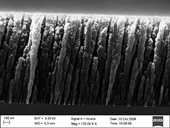Highlight
Improved fuel cell catalyst
Achievement/Results
The decline in worldwide supply of fossil fuels, together with the mounting evidence of the harm to the planet caused by carbon dioxide emissions, have made energy (its generation, storage, and conversion) perhaps the most critical issue facing human society in the 21st century. In his PhD research at RPI, IGERT trainee Mike Gasda has been engaged in the development of PEM (proton exchange membrane) fuel cells, devices that cleanly and efficiently convert chemical energy (stored in hydrogen, which can be generated renewably) to electricity without an intermediate combustion step.
Cost is the primary obstacle preventing mass-market adoption of PEM fuel cells, which have promise in transportation among other applications, and the precious metal platinum (Pt) catalyst is a major component of that cost. To minimize the amount of Pt needed, current commercial processes mix nanoparticles of Pt into an “ink” and spread it onto the membrane; however, it is notoriously difficult to control the structure of the electrode as the ink dries.
Gasda is developing fuel cell electrodes using an entirely different plasma sputtering process that results in controlled nanostructures of Pt and other, cheaper support materials. Pictured below are carbon nanorods grown on silicon by electron-beam evaporation; the bright part at the tops of the carbon nanorods is a coating of 0.1 mg/cm2 of Pt. Because electrodes developed in this way have more predictable structure, even at the nanometer level, he is discovering new relationships between the structure of electrodes and their properties (such as efficiency) which apply even to current electrode technology. This research is at the intersection of many disciplines, from electrochemistry to manufacturing to materials science to sustainability studies. This research will lead to new fuel cells that utilize Pt more efficiently, and in the long-term, toward sustainable and renewable energy generation.
Address Goals
This work would not be possible except for the interdisciplinary approach used. It involved fundamental contributions from a number of different fields, thus furthering the project more effectively than if knowledge from only one field were used.






